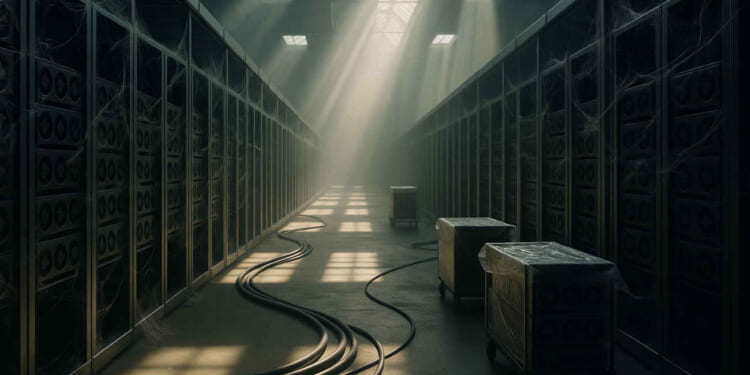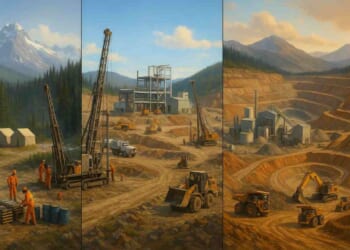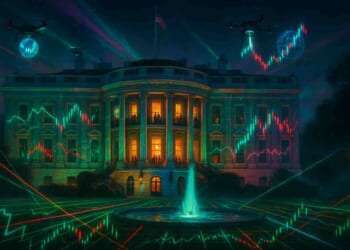Alex Rogo had three months to save his factory.
The plant manager of Bearington’s struggling manufacturing facility watched helplessly as inventories piled high while shipments ran late.
He’d done everything by the book. He maximized local efficiencies, controlled costs, and kept every machine running at full capacity.
Yet throughput kept falling. Management’s patience had run out.
Desperate for answers after a cryptic conversation with his old physics professor, Jonah, Rogo decided to test some abstract concepts during a Boy Scout hike with his son’s troop.
What happened on that five-mile trek to Devil’s Gulch would revolutionize his understanding of manufacturing – and reveal a principle that applies to today’s most pressing industrial constraint: powering the promised, but shaky, AI “revolution.”
Rogo’s story comes from the 1981 book The Goal by Eliyahu Goldratt.
I’ll distill the story’s lessons for you. Then, I’ll apply the lessons to an AI data center constraint – electric power. In the coming months, you’re going to see more news stories about how insufficient power is to blame for keeping the AI data center construction timeline on schedule.
A Walk in the Woods Changes Everything
Alex Rogo set up a simple experiment. The Boy Scouts would march single file with Ron, the fastest kid, leading at a moderate pace. This mimicked a manufacturing line – a series of dependent events where each step relies on the one before it. Rogo hiked at the rear to observe.
He knew the boys’ speeds would vary due to statistical fluctuations. Individual walking rates might range from 1.2 to 2.5 miles per hour, even if their average was 2.0 mph. This natural variation mirrors the unpredictable cycle times in any factory process.
A problem quickly emerged. The troop kept backing up behind one particular scout: Herbie, the slowest boy in the group. His pace governed the entire troop’s speed.
As they climbed a steep hill, Rogo witnessed a disturbing trend. When the faster boys ahead of Herbie sped up, Ron quickly moved half a mile ahead of the pack.
But because each boy depended on the one in front, these fluctuations didn’t average out. Instead, as Rogo realized, “mostly it’s an accumulation of slowness.”
The gap between Ron at the front and Rogo at the back kept expanding. In manufacturing terms, Ron was consuming raw materials while the distance behind him represented work-in-process inventory.
An accumulation of slowness caused throughput – Rogo’s own walking rate, which defined the troop’s actual progress – to slow relative to the growth of inventory.
The insight hit like a thunderbolt: pushing everyone to walk at maximum speed only created excess inventory at the manufacturing plant. Herbie’s slow rate determined the maximum throughput for the entire troop.
The Breakthrough: Put Herbie First
After lunch, Rogo restructured everything. He placed Herbie – the slowest Boy Scout – at the front of the line. The goal, he told the boys, was to arrive at the objective as a team, leaving nobody behind.
Rogo addressed the root cause of Herbie’s constraint. When the faster boys complained about the pace, Rogo challenged them: “If you guys want to go faster, then you have to figure out a way to let Herbie go faster.”
In an amusing revelation, they discover Herbie was lugging an enormous backpack:
Herbie stops and turns around. I tell him to come to the back of the line and take off his pack. As he does, I take the pack from him – and nearly drop it.
‘Herbie, this thing weighs a ton,’ I say. ‘What have you got in here?’
‘Nothing much,’ says Herbie.
I open it up and reach in. Out comes a six-pack of soda. Next are some cans of spaghetti. Then come a box of candy bars, a jar of pickles, and two cans of tuna fish. Beneath a rain coat and rubber boots and a bag of tent stakes, I pull out a large iron skillet. And off to the side is an army-surplus collapsible steel shovel.
‘Herbie, why did you ever decide to bring all this along?’ I ask. He looks abashed.
‘We’re supposed to be prepared, you know.’
Boy Scouts, the old saying goes, are always supposed to be prepared.
Rogo ordered the heavy items redistributed to the other boys. Relieved of his burden, Herbie’s pace quickened dramatically. The troop started marching at twice the speed, while staying together.
The Universal Principle
The Herbie story reveals a crucial principle: any complex system is governed by its weakest link – the constraint. As Professor Jonah later explained in The Goal, the bottleneck determines the effective speed and output of the entire operation.
This proved that managers shouldn’t try to balance capacity with demand. Instead, they must “balance the flow of product through the plant with demand from the market.” The capacity of any plant equals the capacity of its bottlenecks.
Therefore, improvement must focus on managing this single point. Maximizing the output of non-bottlenecks – like letting the faster hikers set the pace – only creates massive excess inventory sitting idle. It doesn’t increase overall system output.
This lesson applies universally. Whether the constraint is a slow Boy Scout, an expensive manufacturing machine, or market demand itself, the Theory of Constraints teaches the same discipline: identify what limits your system’s ability to generate throughput, then exploit that constraint relentlessly.
Today’s Herbie: The AI Power Bottleneck
The most significant constraint holding back explosive growth in artificial intelligence is increasingly not processing speed or algorithm sophistication. A growing body of evidence suggests the real bottleneck is the energy required to sustain these systems.
AI data centers need reliable, baseload electric power. The inability of existing infrastructure to deliver this power now acts as one of the most severe constraints on the industry’s expansion.
U.S. data centers consumed 183 terawatt-hours of electricity in 2024 – more than 4% of the country’s total consumption. It’s roughly equivalent to Pakistan’s entire annual demand. The International Energy Agency (IEA) projects this figure could rise to around 426 terawatt-hours by 2030, assuming current adoption trends remain intact.
Each new data center represents a massive demand that utilities often cannot accommodate. A typical AI-focused hyperscale data center annually consumes as much electricity as 100,000 households, with the largest facilities under construction expected to use 20 times as much.
While some hyperscalers are pursuing on-site generation, renewable power purchase agreements, or hopes for small modular nuclear reactors (by the 2030s) to mitigate the strain, generation capacity is insufficient, and transmission grids are severely constrained. Goldman Sachs estimates approximately $720 billion in grid spending through 2030 may be needed to meet surging data center demand.
The physical constraint is compounded by a policy constraint: a crushing backlog of grid connection permits. Grid connection requests now typically take more than three years to complete the impact studies required in most regions. Some requests in data-center-saturated Northern Virginia are facing seven-year delays.
Just as ineffective material release systems limited the Bearington plant’s performance in Rogo’s story, bureaucratic delays in permitting keep shovel-ready projects offline.
When the CEO Admits He Has a Herbie Problem
Microsoft CEO Satya Nadella recently confirmed what constraint theory predicts: the bottleneck has shifted.
In a candid late October podcast interview, Nadella revealed the real limitation isn’t Nvidia chips anymore (emphasis added):
And it’s the ability to get the builds done fast enough, close to power. So if you can’t do that, you may actually have a bunch of chips sitting in inventory that I can’t plug in. In fact, that is my problem today, right?
It’s not a supply issue of chips. It’s actually the fact that I don’t have warm shells to plug into.
Read that again. Microsoft’s CEO just implied his company has expensive Nvidia GPUs sitting idle – inventory accumulating because the constraint has moved downstream.
This is what happened when Ron sprinted ahead of Herbie. The fast boys created gaps in the line that didn’t increase the troop’s overall speed.
Nadella continued:
So, how some supply chain constraints emerge, tough to predict, because the demand is tough to predict, right? I mean, it’s not like Sam [Altman of OpenAI] and I would want to [say] we are less short on computers because we just were not that good at being able to project out what the demand would really look like…
It’s one thing to sort of talk about one segment in one country, but it’s about really getting it out everywhere in the world. And so there will be constraints, and how we work through them is going to be the most important thing. It won’t be a linear path for sure.
The admission is remarkable. Microsoft and OpenAI risk overestimating their ability to deploy AI infrastructure. They may have committed to Nvidia chips that they cannot plug into the local grid – or get backup generators – in time before they get lapped by competitors, new chips, or new models.
Their capital expenditure forecasts assumed that power and data center construction would roughly keep pace with GPU procurement. They won’t.
This creates a bearish setup for the hyperscalers and their primary supplier.
The Inventory Problem: GPUs Awaiting Grid Connections
Recall Alex Rogo’s expanding inventory problem at the plant he’s trying to save. The distance between Ron at the front and the rest of the troop kept growing, representing a work-in-process that couldn’t flow through the system. In manufacturing terms, this idle inventory consumes working capital without generating throughput.
Microsoft, Oracle, Amazon, Google, and the “neocloud” companies like CoreWeave face the same dynamic. They’ve spent tens of billions on Nvidia GPUs – capital expenditures that get added to property, plant, and equipment on their balance sheets. These assets are supposed to generate revenue through AI services.
But if the GPUs sit waiting for data centers to connect to the grid, they’re just expensive inventory. They don’t generate throughput. They don’t create cash flow. They simply depreciate on the balance sheet while consuming capital that could have been returned to shareholders or invested in projects with clearer paths to deployment.
Microsoft’s capital spending budget has mushroomed since 2016 in the battle with Amazon Web Services and Google Cloud. The company now trades at 13 times sales, up from 3 times sales when risk-free rates were near zero in 2016. That valuation implies enormous confidence in AI monetization. Yet Nadella just confirmed deployment is constrained by power, not chips.
Unless revenue growth soon accelerates for all hyperscale competitors, rising capital expenditure relative to sales will drive operating margins lower. Flat revenue, combined with higher depreciation expenses, results in lower operating earnings. Yet, the market is pricing these stocks for explosive AI-driven growth.
The Political Constraint: Rising Utility Bills
The power bottleneck creates another problem that’s becoming increasingly visible: soaring electricity costs in regions with heavy data center concentration.
In PJM – the grid covering densely-populated areas of Virginia, Maryland, Pennsylvania, and New Jersey – utility bills are climbing rapidly. This is already a political issue. The concentration of hyperscale data centers in Northern Virginia has pushed power demand to unprecedented levels, and residential and commercial customers are bearing some of the cost through higher rates.
President Trump, who has expressed enthusiasm for bringing AI manufacturing and data center development back to America, may find himself navigating a politically challenging situation if electricity costs for ordinary consumers continue rising to subsidize hyperscaler expansion.
The Nvidia Reckoning
This brings us to the most precarious position in the entire supply chain: Nvidia.
Jensen Huang has demonstrated cleverness in maintaining his own supply chain of smoothing GPU demand through creative deal structures. The company has sold GPUs with buyback provisions, arranged barter-style transactions where cloud credits substitute for cash, and exchanged GPUs for venture capital equity stakes.
Many sales go to semi-related parties, including neocloud operators like CoreWeave and Nebius that are themselves funded by hyperscalers seeking additional capacity (or, in Microsoft’s case, are seeking to offload some of the data center construction risk).
These arrangements have propped up reported revenue and sustained Nvidia’s extraordinary margins. Yet they cannot indefinitely offset the physical limits of power availability. If hyperscalers possess GPUs that they cannot fully deploy because data centers lack power or completed “warm shells,” demand growth could decelerate.
These stocks are not priced for decelerating growth.
At some point, Nvidia will need to acknowledge this risk. The company will have to address what happens when its largest customers – who collectively represent the vast majority of GPU demand – slow or defer new orders rather than cancel them outright.
The market implications could be significant. Nvidia now represents roughly 8% of the S&P 500. The stock has the largest call option open interest in the market and the highest retail exposure globally – even in South Korea. Such concentration means a negative demand surprise would reverberate through index funds and derivatives markets.
An Nvidia warning about slowing deployment – not necessarily a collapse in orders, but a timing adjustment – could trigger market volatility similar to the reaction following Intel and Cisco warnings in 2000. However, comparisons must be made carefully: today’s market is more concentrated, more passive (meaning: lighter testing of management claims), and more leveraged through derivatives.
The Unbreakable Chain
The lesson of Herbie applies to today’s AI infrastructure boom. Every complex system moves only as fast as its slowest component.
The hyperscalers sprinted ahead, accumulating GPUs like Ron running half a mile in front of the troop. They maximized local efficiency without ensuring the entire system could flow.
Now they are discovering that throughput depends not merely on chip supply, but on the ability to power and deploy them effectively.
For investors, the implications are clear. Companies trading at premium valuations based on rapid AI deployment face risk if those deployments take years instead of quarters. The stocks most vulnerable are those that have spent most aggressively on infrastructure that cannot yet generate revenue in sufficient amounts relative to their capital and operating costs: Microsoft, Oracle, and their peers in the hyperscale arms race.
Alex Rogo learned the hard way that you can’t optimize individual components and expect the system to work. You must manage the constraint.
















